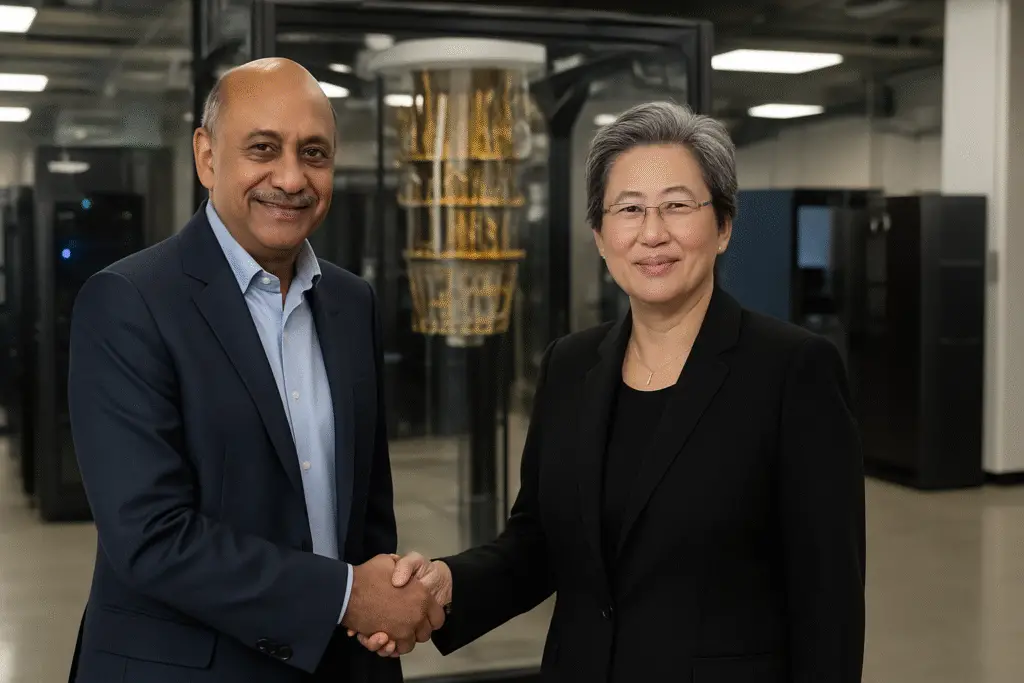In a bold step toward reshaping the future of technology, IBM and AMD join hands to create a new model of computing that blends quantum systems with high performance hardware.
This collaboration promises to revolutionize how information is processed, pushing beyond the limits of traditional computing and unlocking opportunities for industries ranging from healthcare to climate science.
The partnership between IBM and AMD isn’t just another corporate alliance it’s a strategic vision for the future. IBM, a leader in quantum computing, brings decades of innovation and breakthroughs, while AMD, known for its advanced processors and GPUs, provides the horsepower needed for high performance computing (HPC).
As Arvind Krishna, Chairman and CEO of IBM, explained, Quantum computing will simulate the natural world and represent information in an entirely new way.
By exploring how quantum computers from IBM and the advanced high performance compute technologies of AMD can work together, we will build a powerful hybrid model that pushes past the limits of traditional computing.
This hybrid model aims to create an environment where quantum and classical systems co-exist seamlessly, combining strengths to solve problems that neither could tackle alone.
Why This Partnership Matters
The world is at an inflection point where traditional computing is struggling to keep up with the exponential growth of data and the complexity of global challenges.
Fields like drug discovery, financial modeling, and climate prediction demand computing capabilities that go far beyond what today’s supercomputers can deliver.
Quantum Computing Strengths Quantum systems excel in solving complex problems that require massive parallelism, such as molecular simulations.
AMD’s Role AMD’s processors and accelerators are designed to maximize efficiency and performance, creating the ideal hardware backbone for quantum classical integration.
By merging these strengths, IBM and AMD join hands to deliver solutions that can address real world challenges faster and more accurately.
Several industry experts have weighed in on the significance of this move. Dr. Karen Hao, Tech Analyst at MIT Review, notes, The IBM AMD collaboration signals a shift toward hybrid architectures.
The future won’t be purely quantum or purely classical it will be a blend that balances speed, scalability, and reliability. Michael Carter, CTO of QuantumFrontier, adds, This partnership is about more than just hardware.
It’s about ecosystems. Combining IBM’s quantum roadmap with AMD’s silicon expertise could set the foundation for scalable systems that enterprises can adopt in the next five years.
These expert perspectives highlight how the alliance is not just visionary but also grounded in practical applications that industries desperately need.
Quantum Meets High Performance Computing in Drug Discovery
To understand the potential, let’s look at a real world case study from the pharmaceutical industry. Traditional drug discovery takes years and costs billions, partly because simulating molecular interactions at the quantum level is nearly impossible with classical systems.
With IBM’s quantum systems, researchers can model these interactions more accurately. By integrating AMD’s high performance compute power, these simulations can be scaled and processed faster, shortening the discovery timeline.
For example, early collaborations between IBM and pharmaceutical companies have already demonstrated how quantum algorithms can optimize molecule design. With AMD’s HPC hardware in the mix, this process could move from theoretical models to practical breakthroughs in record time.
As someone who has witnessed the evolution of computing firsthand, I can say this partnership resonates deeply. I remember working with traditional mainframes that filled entire rooms, only to see laptops and GPUs redefine performance within decades.
The announcement that IBM and AMD join hands feels similar to those transformative moments. It’s not just about speed or efficiency it’s about redefining what’s possible.
For professionals in technology, science, and even business, this collaboration is a beacon of innovation that will shape careers, industries, and societies.
Of course, this vision isn’t without hurdles, Scalability Quantum computers are still in their early stages, with limited qubits and stability issues. Integration Complexity Bridging two radically different computing architectures is no small feat.
Accessibility Making these systems affordable and usable for industries beyond large corporations remains a challenge. Yet, history shows that when two industry leaders come together, these challenges often transform into opportunities.
Just as GPUs evolved from gaming hardware into AI accelerators, quantum classical hybrids could become the foundation of next generation enterprise computing.
Future Implications Across Industries
The IBM AMD collaboration has the potential to touch virtually every sector, Faster drug development, precision medicine, and genomic analysis.
Advanced risk modeling, fraud detection, and portfolio optimization. More accurate climate models to guide sustainability strategies. Hybrid models that enhance training efficiency and reduce energy costs.
By working together, IBM and AMD join hands to create systems that address humanity’s most pressing challenges, from curing diseases to tackling global warming.
This partnership isn’t just about technology it’s also about market positioning. IBM gains a stronger foothold in the hardware ecosystem, ensuring its quantum systems can integrate with world class processors.
AMD strengthens its brand as a key enabler of next gen computing, extending its role beyond CPUs and GPUs into hybrid architectures.
In a world where competition from giants like NVIDIA, Intel, and Google is fierce, this collaboration offers both IBM and AMD a strategic edge.
A Leap Toward the Future
When history looks back at this moment, it may be remembered as the time when two giants decided to step beyond competition and collaborate for the greater good.
By blending IBM’s leadership in quantum with AMD’s dominance in high performance computing, the partnership sets the stage for a future where IBM and AMD join hands to deliver breakthroughs that redefine what technology can achieve.
This is not just about computing it’s about humanity’s quest to solve the unsolvable, to push boundaries, and to create a world where technology empowers progress on a scale never seen before.

